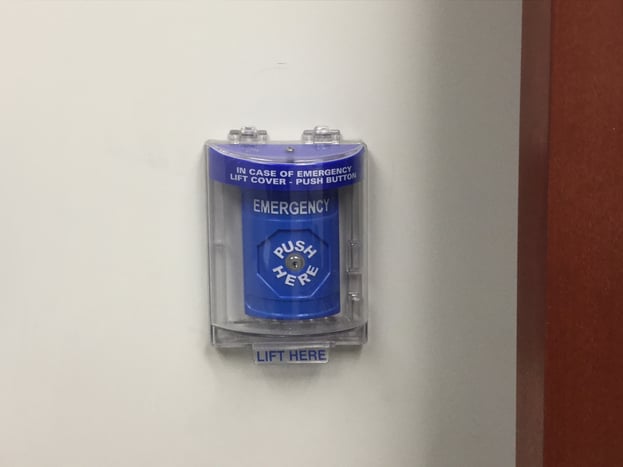When I ask about duress alarms during a security assessment of a workplace or government facility, the typical response I get is, "I'm not sure if we have them." Or, “We removed them because we kept setting them off by mistake.”
A duress alarm, alternatively known as a panic button or distress alarm, is a security mechanism created to quickly notify others during a dangerous or urgent event. Unlike most security devices, these alarms are not for protecting buildings or objects but for the safety and security of the building users.It is typically an inconspicuous electronic device about the size of a doorbell and designed so that when pressed, it alerts security personnel of an emergency.
I have also seen versions that are large and more prominently installed on walls, such as in the image below. The smaller ones can be activated discreetly, while the large and prominent variety is designed to be easily found and used by a larger range of personnel in a facility.

Duress alarms should be integrated with a building’s overall security system. Doing so will enable security personnel to be alerted to the exact location of an emergency.
Who Requires Duress Alarms?
Certain types of buildings or facilities are considered at a higher risk due to the nature of their operations or the types of interactions they have with visitors. These include schools, hospitals, courthouses, and police stations. Any place that may be more susceptible to workplace violence could benefit from installing a duress alarm system.
Government buildings that provide services requiring interaction with members of the public (code enforcement, tax assessor, social services, public health facilities, etc.) are another example of where volatile situations might occur.
Frustration over bill payments, fees, or other services may cause tension and aggression that can escalate into a distressing situation for the staff member dealing with the individual(s).
When these tense situations occur, and the staff member feels threatened by that aggression, activating a duress alarm can bring aid to the staff member in the form of security personnel or other emergency responders.
Types
There are many types of duress alarms specifically designed for different uses, such as pressure mat alarms that are activated when someone steps on a specific mat or sensor, voice-activated duress alarms that can be triggered by specific verbal commands, or ones that can be set to automatically activate after a predetermined time of non-contact with the user.
However, the most common is the panic-button style of alarm that can be used by receptionists, interviewers, or other people inside a government building, office, or workplace.
Operation
Typically, the panic button is mounted under a reception desk or the staff side of a public service office or counter. It is often hardwired to the duress alarm system, but there are also wireless panic buttons and portable ones that can be carried. If an extremely discreet alarm activation is required, the duress system could be connected to the user’s computer workstation and be activated by a keystroke or simple combination of keys.
Pressing the button sends a signal to building security personnel and/or directly to a 911 dispatcher that a threatening situation is occurring. The button can also activate an audible alarm, or if discretion is required, could just activate a silent alarm.
Training
The individual using the duress alarm needs to be trained on the proper use of It and the response after activation. Key points of any training should include the following:
- Explain the purpose of duress alarms to give the user an understanding of how to quickly signal distress or emergency situations, providing the most rapid response from security personnel or authorities.
- Provide information about the location of duress alarms within the facility. Staff with alarm activation buttons under a desk or counter need to be fully aware of the buttons’ locations, not just to be able to activate them but also to prevent accidental activation.
- For duress alarm stations in more general locations, users need to understand the strategic placement of these devices.
Testing
- Alarms should be tested at least twice a year to verify that the system is in operation and that the proper emergency personnel are contacted.
- Testing should be an intrinsic part of the training regimen. A fundamental part of testing the system is ensuring that the intended users of the duress alarms are able to find the button during an emergency and press it quickly.
- The testing should be a part of a broader preparedness exercise that involves first responders and other emergency personnel being actively part of the exercise to test the emergency call system and response time in as close to a real-world scenario as possible.
- Regular reinforcement through drills and testing ensures that the people who need duress alarms are capable of using them effectively during an actual emergency and are confident of the response.
Tailor the Duress Alarm System to Your Needs
The final choice of what kind of duress alarm best aligns with the security objectives and operational requirements will depend on the specific needs of the workplace or organization, the integration required with the overall security systems, and the users' preferences.
The important features of any system should include ease of use, integration with other security systems, and training to provide user confidence with the duress alarm system.
It should be part of a comprehensive security strategy in government buildings and other vulnerable workplaces to mitigate risks, protect personnel, and ensure the overall safety and security of the facility.



.jpg)
.jpg)
.jpg)
.jpg)
-1.jpg)
.jpg)
.jpg)
.jpg)
-1.jpg)
.jpg)
.jpg)
.jpg)
.jpg)
.jpg)

